Shaken… and slightly stirred
I CARRY a camera everywhere, because you never know when a good photograph is round the corner. I also just grab the camera from my office, and rarely think to check the settings. Today, I managed to shoot everything with Super Steady Shot (Anti-Shake) carefully switched off on my Alpha 100.
In the studio, or when making tests, I may switch SSS off. It’s not needed or desirable with tripod shots, or flash. In fact it can spoil tripod shots by reacting incorrectly to reflected vibrations. Now I have been reminded that I should switch it back on the moment the tripod or flash shoot is finished. That’s what I mean by slightly stirred. Memory stirred. Or intentions. Whether I will remember and intend is another matter.
I only photographed three situations when spending a couple of hours in Edinburgh. I parked near the mosque, which happens to be surrounded by good cafés and close to a music shop I wanted to visit. Ten minutes waiting for good sun on the mosque itself failed me, but in walking on my route I passed a university building with carefully preserved old signs:
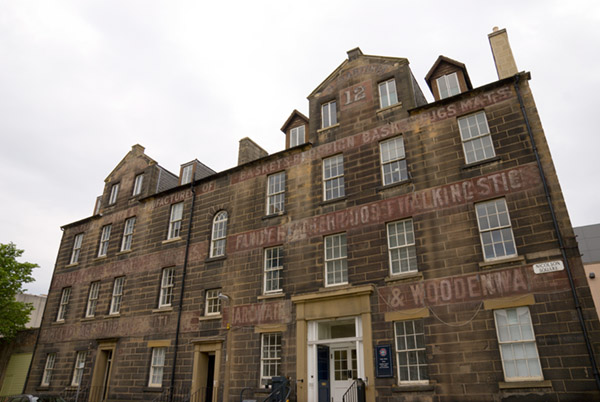
This is not a ‘good’ photograph but like many I take, it may have a value to someone writing about architecture, history, or conservation. I’ll revisit it on a better day. It was taken at 16mm on the CZ 16-80mm, carefully focusing at 35mm before zooming back to 16mm, as the lens never focuses accurately at the extreme wide end on the A100. The exposure was a very safe 1/100th at f/10. Even so, the image is not as sharp as I have come to expect from routine hand-held shooting with SSS enabled.
In a café for a quick lunch, the scene in front of me struck me as pretty good with one internet wifi connection user concentrating on his laptop. A longish first exposure reminded me to switch to ISO 400, but I didn’t check the SSS switch. Nor did I manage to focus any of four different shots as intended. The AF despite being set for centre focus tended to hit the background scene. The CZ, despite being the best lens around optically, is not making friends with me right now.
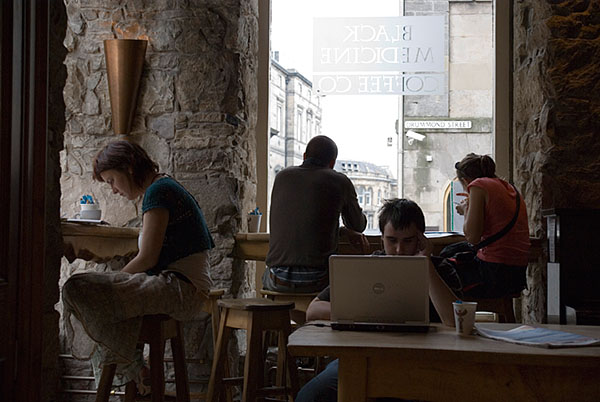
While the lighting is natural, it’s not what I needed for an internet café scene which might find a use in my markets – serious newspapers, magazines, and books or websites wanting natural-looking real life shots. The Black Medicine Coffee Co offers entirely free wifi, and I guess a return visit from time to time might produce a better image. I am happy with the compositional flow, the relative positions of the heads (the elements to which the eye is drawn) but it’s not the best shot, just the best focus.
However, on departing I visited the subterranean loo (Edinburgh basements generally provide loo space) and passed a truly classic composition, partly created by the café’s own decor and lighting, and partly by a perfectly poised Mac Powerbook user with a glowing Apple symbol and a scatter of still-life elements in best Dutch school arrangement!
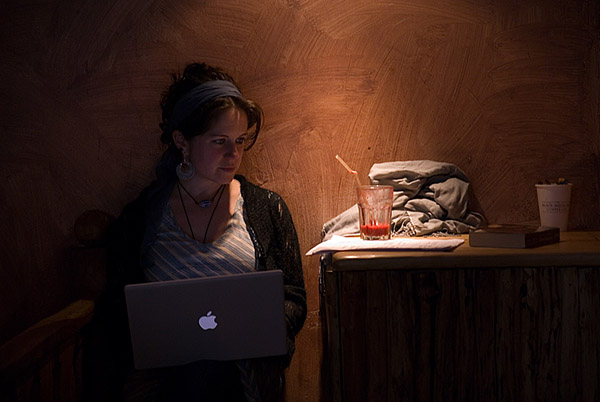
While I will shoot a group of people without asking, I won’t aim my lens at a single individual without the courtesy of asking permission. There was no problem apart from folk milling about between my lens and my sitter, who was asked just to keep working and not worry about the camera. But, aware that I should work quickly and not take endless pix, I once again failed to spot the SSS was turned off. The exposure was running at around 1/25th wide open, at the long end of the lens. In Leica or Minolta CLE days I would not have thought twice, I could hand-hold this, but I would have taken great care. Breathe in, calm the body’s natural sway, squeeze the shutter smoothly. SSS has made me careless. Also, the small viewfinder of modern DSLRs has made me less aware of focus. For reasons everyone will know, the central focus locked on to the wall, not my subject. I thought I had locked and recomposed, but perhaps the lens made a final tweak and revised my setting. At f/4.5, this was enough to take the edge off the shot. Like it or not, there was shake. All three frames I shot showed shake, one so badly it was not usable. The chosen shot here was on the verge of being unusable when enlarged to A3+ picture library dimensions:
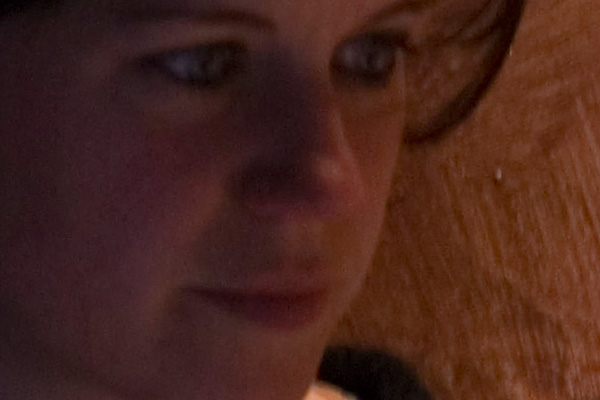
This gives a very unfair view of the shot, since it is enlarged to 17.5 megapixels, and when output to a size suitable for a 6 x 4 inch print it’s as sharp as you could want. We used to try to judge images from 6 x 4 prints. Now, we really can see that bit of directional shake and that focus error. Even so, with the softness and slight ISO 400 noise, it has a painterly look and will go in the library.
But can anything better be done?
Photoshop provides an answer. One of the very oldest Artistic Effect filters, Watercolour Paint, is a favourite of mine for prints on watercolour type paper from images which are small, or have focus errors, or noise. It quantises the image into blobby posterized zones with ragged bleed edges and a random overlap. Applied to a shot like this, it also creates perfectly sharp edges to the face and hair, while brightening the eye-whites and the Apple logo. The overall image processed through the Watercolour Paint filter (settings 9, 1, 0) loses any of the distracting imbalance between the sharper painted wall and the portrait element. It also looks uncannily like many of the real art prints on show just over the road from the café! Slightly Vettriano in feel, with solid blacks and simple outlines. Here is a section, after watercolour processing:
If you click the photo, you will open a full sized clip (at the size suitable for A3 to A2 printing on watercolour paper). The artificial edges created by the watercolour filter are most effective, and it handles the colour in skin tones well despite producing a dense black for the hair and charcoal shades for the shoulder wrap.
Obviously there are very few images where this is appropriate treatment, and it is an off-the shelf filter, which makes it not really your own creative work. There are some other options – programs like Painter, and sets of special effect filters – but the same can be said of these as well. In the end, if the process applied to an image makes it serve its purpose better or enhances it visually, reasonable productivity dictates that it’s OK to use ready made shortcuts.
And one shortcut I must remember not to take is to grab the camera without checking every single setting – including the SSS switch. It is just too easy to shoot all day with it off. In my experience SSS will sharpen up many shots at normal shutter speeds, let alone those at hard to handhold settings. I didn’t lose my shot, but it could have been better.
As a footnote, in sending my subject a copy of her portrait, I realised we had spoken before (Edinburgh is a very small place) – at a Friends of the Earth Scotland booth during one of the many green festivals or events which happen in the city.
– David

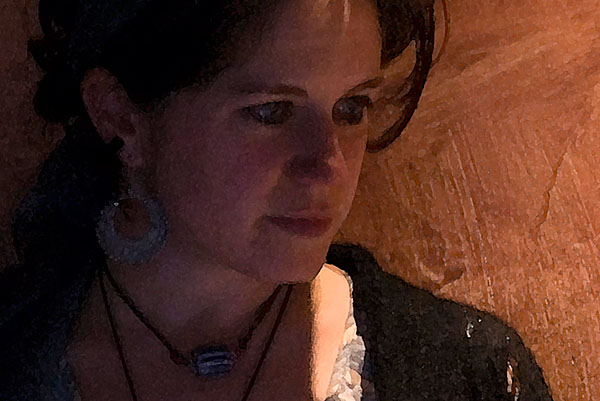
I’ve left AS/SSS off a few times. Now I try to remember to look for the ‘shakeometer’ in the viewfinder when starting a session. Andy